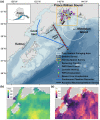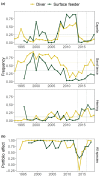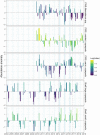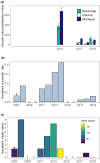Heatwave-induced synchrony within forage fish portfolio disrupts energy flow to top pelagic predators
- PMID: 33577102
- PMCID: PMC8048560
- DOI: 10.1111/gcb.15556
Heatwave-induced synchrony within forage fish portfolio disrupts energy flow to top pelagic predators
Abstract
During the Pacific marine heatwave of 2014-2016, abundance and quality of several key forage fish species in the Gulf of Alaska were simultaneously reduced throughout the system. Capelin (Mallotus catervarius), sand lance (Ammodytes personatus), and herring (Clupea pallasii) populations were at historically low levels, and within this community abrupt declines in portfolio effects identify trophic instability at the onset of the heatwave. Although compensatory changes in age structure, size, growth or energy content of forage fish were observed to varying degrees among all these forage fish, none were able to fully mitigate adverse impacts of the heatwave, which likely included both top-down and bottom-up forcing. Notably, changes to the demographic structure of forage fish suggested size-selective removals typical of top-down regulation. At the same time, changes in zooplankton communities may have driven bottom-up regulation as copepod community structure shifted toward smaller, warm water species, and euphausiid biomass was reduced owing to the loss of cold-water species. Mediated by these impacts on the forage fish community, an unprecedented disruption of the normal pelagic food web was signaled by higher trophic level disruptions during 2015-2016, when seabirds, marine mammals, and groundfish experienced shifts in distribution, mass mortalities, and reproductive failures. Unlike decadal-scale variability underlying ecosystem regime shifts, the heatwave appeared to temporarily overwhelm the ability of the forage fish community to buffer against changes imposed by warm water anomalies, thereby eliminating any ecological advantages that may have accrued from having a suite of coexisting forage species with differing life-history compensations.
Keywords: Gulf of Alaska; ecosystem response; forage fish; marine heatwave; portfolio effects.
© 2021 The Authors. Global Change Biology published by John Wiley & Sons Ltd.
Figures










References
-
- Abookire, A. A. , & Piatt, J. F. (2005). Oceanographic conditions structure forage fishes into lipid‐rich and lipid‐poor communities in lower Cook Inlet, Alaska, USA. Marine Ecology Progress Series, 287, 229–240. 10.3354/meps287229 - DOI
-
- Alaska Department of Fish and Game . (2019). Scales as growth history records for Pacific herring in Prince William Sound. Alaska Ocean Observing System Gulf of Alaska data portal. Retrieved from https://gulf‐of‐alaska.portal.aoos.org/#metadata/35fd35d8‐f6f1‐4762‐9cf0...
-
- Anderson, P. J. , & Piatt, J. F. (1999). Community reorganization in the Gulf of Alaska following ocean climate regime shift. Marine Ecology Progress Series, 189, 117–123. 10.3354/meps189117 - DOI
-
- Arimitsu, M. L. , Piatt, J. F. , Heflin, B. M. , & Marsteller, C. E. (2017). Pelagic ecosystems forage fish component – Data from Prince William Sound: Distribution, abundance, and morphology of fish, zooplankton, and predators and oceanographic conditions (ver 2.0, November 2020): U.S. Geological Survey data release. 10.5066/F74J0C9Z - DOI
-
- Arimitsu, M. L. , Piatt, J. F. , Litzow, M. A. , Abookire, A. A. , Romano, M. D. , & Robards, M. D. (2008). Distribution and spawning dynamics of capelin (Mallotus villosus) in Glacier Bay, Alaska: A cold water refugium. Fisheries Oceanography, 17(2), 137–146. 10.1111/j.1365-2419.2008.00470.x - DOI
MeSH terms
Grants and funding
LinkOut - more resources
Full Text Sources
Other Literature Sources

